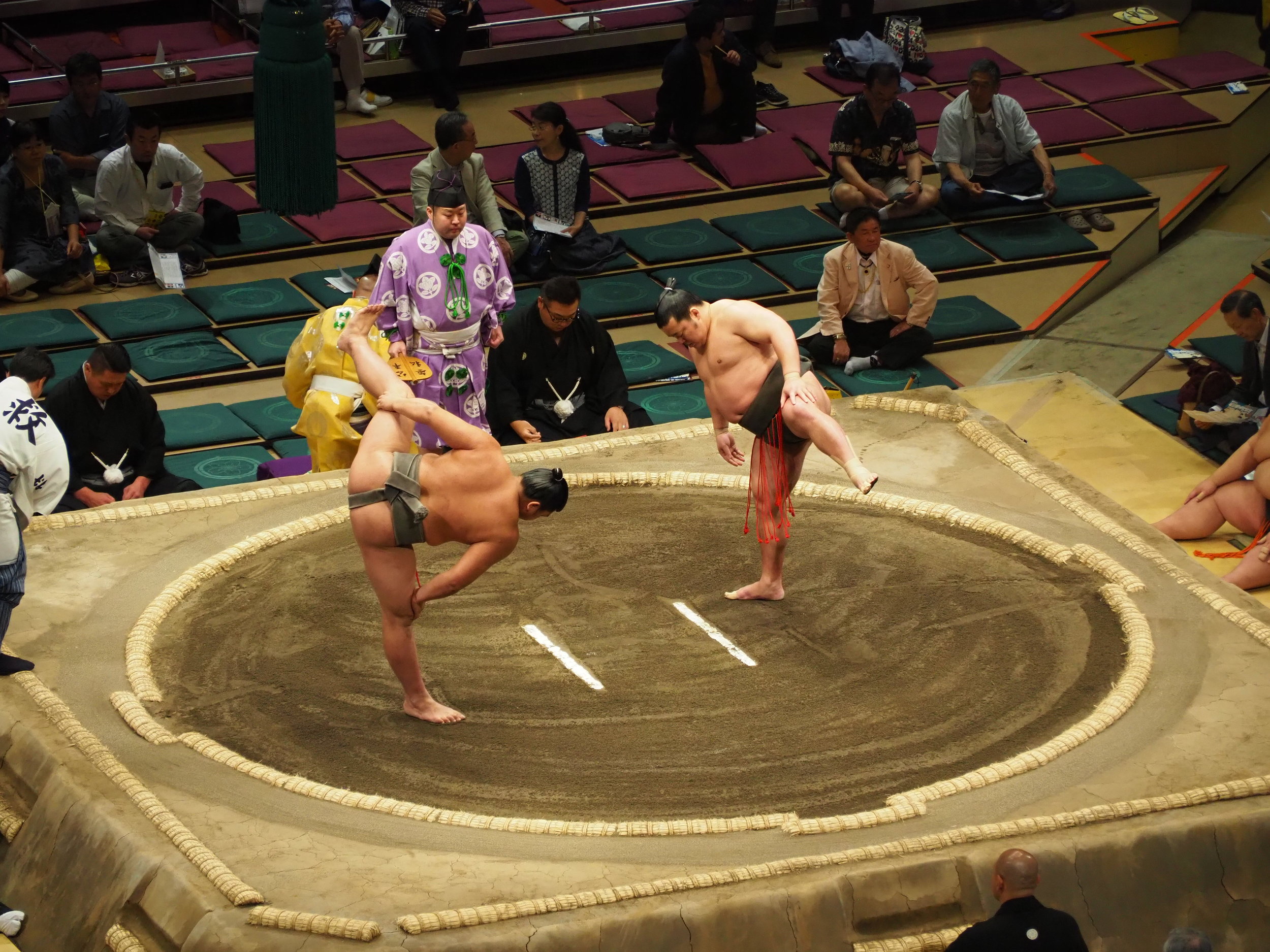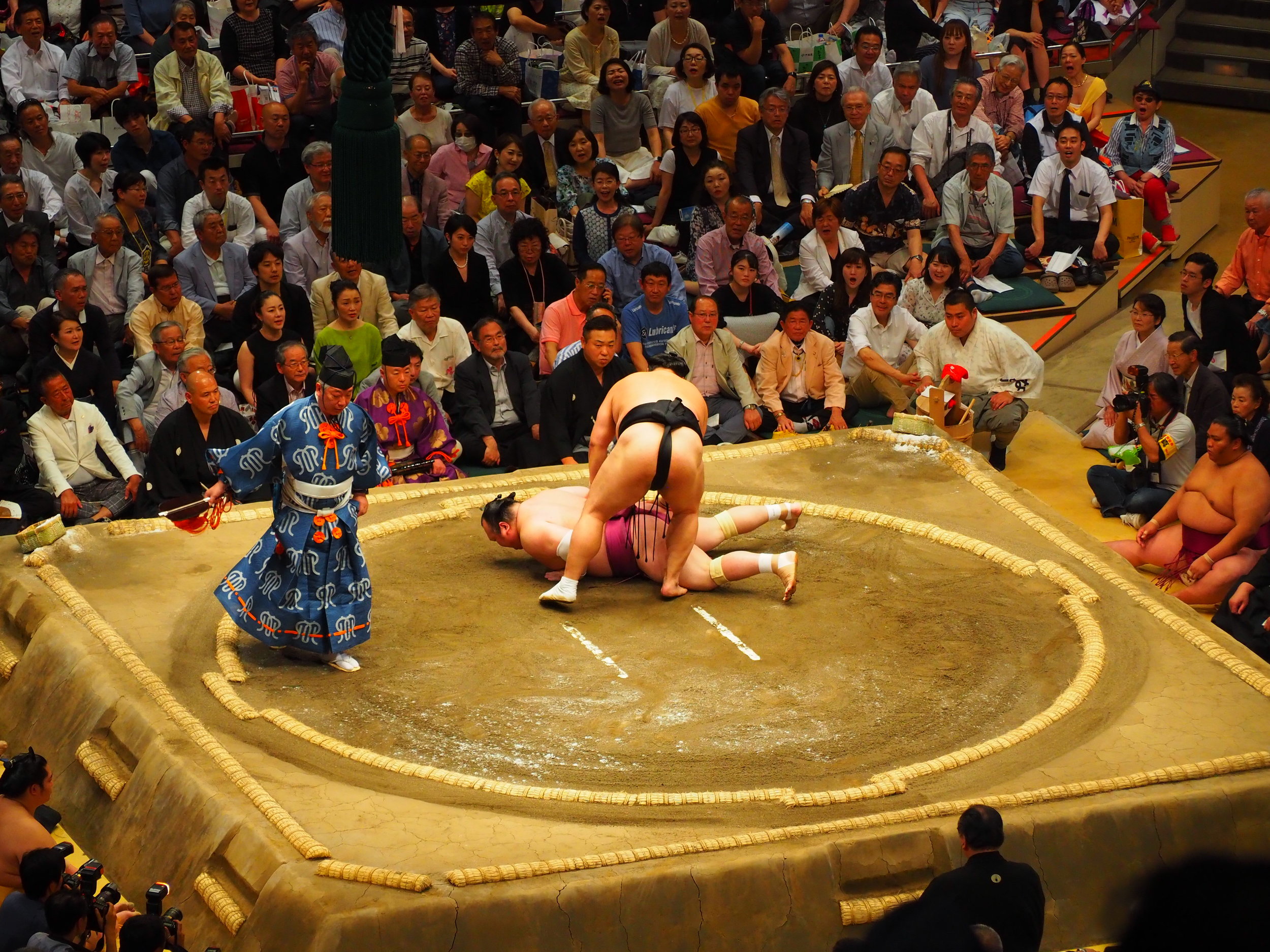A day at the sumo
Despite living in Japan, going to the sumo isn’t an easy or as a frequent occurrence as you’d think. The major tournament only takes place during certain times of the year and matches take place all across the country, so we needed to plan ahead to make sure we got tickets for one of the rounds in Tokyo! But Wil and I finally made it to the sumo for the first time in May! In this post, I’ll share bits from our day at Tokyo’s main sumo hall, the Ryōgoku Kokugikan. This post has a lot of photos so you may need to wait a few seconds for them to load as you scroll down.
I, obviously, started to get in to the sumo spirit even before we entered the arena because I will never turn down a good photo opportunity.
The sumo matches start early in the morning (when the wrestlers from the lower divisions are competing) and the crowd pulling matches are after lunch. We decided to get to the stadium for around noon as weren’t too fussed about seeing the morning’s matches (and thought 6 hours would be enough for one day). As we approached the arena, we could see people waiting to see the wrestlers competing in the afternoon arriving so we joined in with the enthusiastic loitering. Once inside the complex, we spent a little while walking around looking at the ridiculous number of souvenirs being sold. I talked Wil out of buying a few of them.
We entered the arena itself around 1pm. The sumo ring structure is pretty eye catching. The roof is meant to resemble a shrine roof (and Shinto principles are part of the sport) and the tassels represent the four seasons. The giant Japanese flag also added something to the general atmosphere and aesthetic, improving any photos we took of the arena.
There are two types of seating at the sumo: (i) traditional floor seating with cushions in a box which are closer to the action or (ii) chairs in the stands higher up. Mainly based on cost, we had opted for the cheaper chairs and our view was way better than I had hoped for. Here’s a few photos to give you a sense of the place. It took us a little while to realise that the white boards were the names of the wrestlers in each match, and the winner’s name is lit up afterwards.
Luckily for us the sumo rules are simple so we could follow along easily. A wrestler wins a sumo match if their opponent ends up outside the ring or if any part of their opponent’s body, other than their feet, touches the ring floor. Each sumo match is very short, some can just be a few seconds or a few minutes at most. Often the pre-match ritual lasts longer than the match itself. The pre-match ritual is quite theatrical and begins whilst the previous match is still taking place. Both wrestlers enter the arena from opposite sides and sit across from each other either side of the ring. Once they’re in the ring, the rituals begin properly: they raise their legs impressively high for men so girthy, squat, clap their hands, do some more raising of legs etc, stomp pretty fiercely, have some special water, raise their arms to show they are hiding no weapons... all the stuff you want to see to get you in the mood for a close combat sport. It is all very exaggerated which adds to the drama. The wrestlers may even repeat some of the steps and spend a lot of time glaring at each other to build tension. Oh and they even throw some salt into the ring. Who know that sumo wrestlers were the original salt bae.
Here are some photos from the pre-match rituals. The final photo shows some men holding banners which are paraded around the ring before matches start - these banners represent sponsorship, with each banner worth ¥62,000 (usually between £420-455 depending on the exchange rate) and the winning wrestler will get most of that. We didn’t really see many sponsorship banners for the matches from the lower leagues but think there were over 30 in one of the higher division matches.
With the small matter of the pre-match rituals out of the way, the matches themselves start. Here are some of my favourite action shots from the matches.
For each match, Wil and I would guess which wrestler was going to win the match. I was freakishly accurate and picked the winning wrestler about 90% of the time. Here are some of the match winning moments from the day - the takedowns can be pretty amusing and dramatic.
One of our favourite bits of the day were the parades when the wrestlers from one division all come out into the ring together, wearing what I can only describe as a fancy apron meets loin cloth.
I don’t think any of us think of fashion or style when we think of the sumo but an unexpected highlight for me was the referees’ garb. Here are some of the sassiest and most fabulously dressed referees from the day.
Here are some wrestlers looking particularly chonky. And also my chonky snack (pancake filled with custard).
So, what was our overall verdict on the day? We enjoyed and got into the sumo far more than we had anticipated - because each match is so short, you stay pretty engaged and experience the high of each match starting and its climax without getting bored in between and are then immediately caught up in the drama of the next match. But at the same time, because there were so many matches, we didn’t worry about missing the action when we nipped out to get food and I even squeezed in a bit of sumo trivia reading on my phone (check out the bonus fact section at the end of the post if you’re intrigued).
Although, we had no idea who individual wrestlers were (I really couldn’t be bothered to look them up as part of my sumo trivia reading), it was pretty evident from the audience’s reaction when the favourites came on and get caught up in the atmosphere.
I’d probably like to go again if we can!
Setting the scene for as I wrote this blog:
Location: I actually wrote all of this post at home which I don’t do that often.
Weather: I am writing this in mid-June. It is 29°C and it is the middle of Tokyo’s rainy season but today is a dry day so I probably should go out soon.
Soundtrack: Background trashy tv.
Bonus fact: sumo wrestlers are not allowed to drive.
Bonus, bonus fact: whilst many people may assume that sumo is dominated by Japanese wrestlers, many of the top wrestlers have recently been Mongolian
Triple bonus fact: being a hairdresser for sumo wrestlers is serious business and it is a key job in the Japan Sumo Association. Hairdressers start young and work their way up. It can take ten years before they reach the level at which they can style the ginkgo leaf-shaped top knot that sumo wrestlers in the top two divisions wear. There are only two top rank hairdressers and only they are permitted to style the hair of the highest ranked wrestlers.












































































